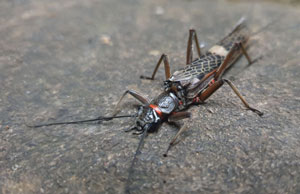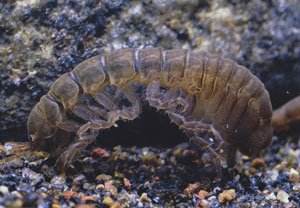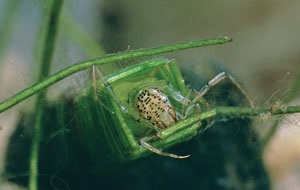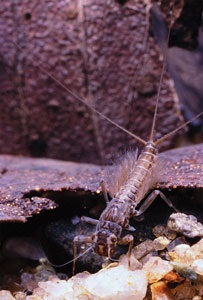The world of waterbugs is completely alien to most people, but for those willing to explore this miniature aquatic kingdom it is full of mystery, wonder and some of the strangest creatures on the planet.
In Hobart freshwater macroinvertebrates inhabit the city's streams and rivulets and are being used to measure the ecolgocial health of our inland waterways.
Mountain shrimp
Mountain shrimp live in the pools of the Hobart Rivulet just above Strickland Falls. They are more common in rivulets higher up the slopes of kunanyi/Mt Wellington.
These animals have barely changed their form since the Carboniferous period, 300 million years ago. They were described from fossils before the first living examples were discovered in Hobart in 1893.
Photo: Copyright © John Gooderham & Edward Tsyrlin
U-sthenid stonefly

As a nymph, these insects terrorise the rest of the waterbug world in Hobart's rivulets. They hunt at dawn and dusk, moving around and under rocks and woody debris, running down sideswimmers and mayflies just as they are turning in for the night.
This waterbug lives as a nymph for a couple of years before emerging as a fully-fledged stonefly to look for a mate. They are quite common along walking tracks of our rivulets between November and June. When startled or threatened the adult stonefly flares up, showing its red hind wing.
Photo: Daniel Rhodes

Cow shrimp
Cow shrimp are the stars of Lambert Rivulet, where for some reason they are more common than in other rivulets. They live in the leaf litter that accumulates behind cobbles in the rivulet.
Cow shrimp are slow-moving, but well armoured, like miniature armadillos.
Photo: Copyright © John Gooderham & Edward Tsyrlin
Sideswimmers
Sideswimmers can grow to the size of a 5 cent piece. Their body is flat, allowing them to slot between cobbles and leaves, which they shred to bits while feeding.
These are the most numerous waterbugs in the upper parts of Hobart Rivulet and are likely an important food source for platypus.
Photo: Copyright © John Gooderham & Edward Tsyrlin

Log cabin caddis
Many caddis are master builders, the larvae create protective structures from materials at hand – sand grains, silk, or in the case of the log cabin caddis, freshly-cut water weed lumber.
The structures caddis build are completely mobile, allowing the caddis to move around underwater in their own mobile mini-home.
Photo: Copyright © John Gooderham & Edward Tsyrlin

Tinsel-gilled mayfly
There are many mayfly species in Hobart's rivulets.
The tinsel-gilled mayfly has distinctively fluffy gills along its abdomen. Absence of mayflies indicates pollution in our waterways, which is why they are the mascot for the National Waterbug Blitz.
Photo: Copyright © John Gooderham & Edward Tsyrlin